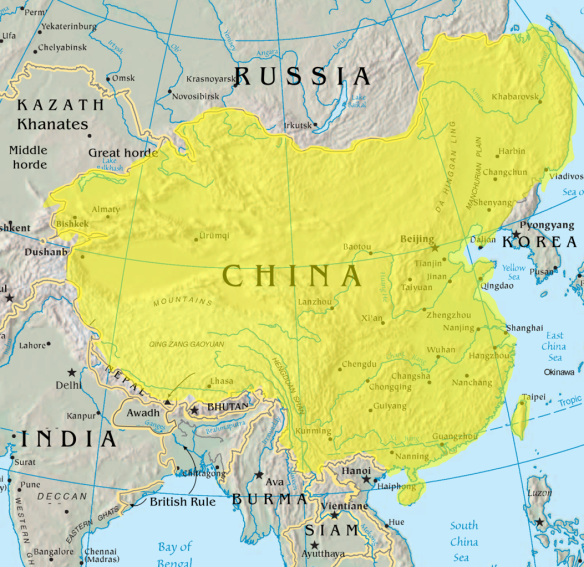
Qing dynasty at its greatest extent in 1820.
The central difference, of course, was that whereas Mongol unification lasted barely 90 years, Manchu conquests survived to the end of the imperial era in 1911. What is more, insofar as the bulk of Qing annexations were retained by 20th-century governments, the Qing lay the foundations of the modern Chinese nation-state. All told the Qing more than doubled Ming territory through acquisitions in Manchuria, Mongolia, Xinjiang, Qinghai, Tibet, and Taiwan. Although Manchus, like other Inner Asians, were inspired by Mongol example, their expansion north and west of China proper responded more directly to concerns about Russian encroachment and to fear that the Zunghar, or Western, Mongols might effect an anti-Qing alliance with Tibet.
Ultimately, to follow Peter Perdue, Qing conquests proved more durable than those of either the Mongols or the Ming for four reasons. First, in contrast to the Ming, whose Chinese ethnicity and lower Yangzi base partially isolated them from Inner Asia, Manchus were intimately familiar with the steppe. China’s perennially inadequate supply of horses meant that imperial power could extend beyond the Great Wall only with the help of Mongol cavalry, whom the Qing won over through a mix of religious patronage, marriage alliances, diplomacy, economic lures, and force. Second, Chinese economic expansion provided the Qing with greater internal resources. The Ming, like the Song, tried to supply grain and horses to frontier garrisons by providing merchant incentives, but the economy was insufficiently monetized to make this work. By the mid-1700s, however, Qing officials could purchase large supplies on the markets of northwest China and ship them out to Xinjiang. And when prices in the northwest rose sharply, the civilian state granary system, another essentially mid-Qing innovation, could relieve local distress. The Qing also strengthened ties between newly conquered territories, principally Xinjiang, and China proper through large-scale Chinese settlement. Third, the new civilian granary system was symptomatic of a general increase, both secular and cyclic, in administrative efficiency during the early and mid-Qing. The aforementioned reforms, in particular the Grand Council and the system of palace memorials, allowed the Qing to respond more quickly to frontier problems and mobilize resources more efficiently than the Ming. By the same token, Jesuit cartography produced more accurate maps, while Western-style artillery figured in some of the Qing’s Inner Asian campaigns.
Finally, Qing expansion benefited from simultaneous Russian advances. Even if they could defeat the Mongols, the Ming could never close off escape routes into the steppe. As Russia and China, who signed frontier treaties in 1689 and 1727, divided much of Inner Asia between them, however, the space for nomad maneuver contracted. For three generations the Zunghar Mongols of Xinjiang strove with astounding energy and imagination to construct an independent empire, but trapped between the Qing hammer and Romanov anvil, their project collapsed in the 1750s. For their part, the Russians were motivated to join the Qing both by security considerations and by the lure of the China market.
Thus by 1760 the Qing could boast something no previous dynasty had achieved: ending the two-millennia threat from the Inner Asian steppe.